Comparison of Transboundary Water Resources Allocation Models Based on Game Theory and Multi-Objective Optimization
Abstract
:1. Introduction
2. Materials and Methods
2.1. Study Area
2.2. Transboundary Water Resources Allocation Based on Asymmetric Nash–Harsanyi Leader–Follower Game Model and Its Solution
- Let be the initial feasible solution of the optimization problem, and the corresponding objective function value is ;
- The nonlinear objective function is linearized by using the first order descriptive form point of Taylor series, and the optimal solution of linearized objective function in the neighborhood is obtained by using the linear programming method;
- Taking the optimal solution as a new feasible solution, the nonlinear objective function is linearized again by using the first order description point of Taylor series, and the optimal solution of linearized objective function in the neighborhood is obtained by using the linear programming method;
- Repeat the above step 3 for the optimal solution and continue to iterate until the obtained optimal solution and the optimal objective function meet the condition of iteration termination.
2.3. Transboundary Water Resources Allocation Based on Multi-Objective Optimization Model and Its Solution
2.3.1. Transboundary Water Resources Allocation Based on Multi-Objective Optimization Model
2.3.2. Multi-Objective Optimization Method
- An initial population of size is randomly generated, save the population to an external document , and multi-objective optimization method based on objective decomposition is used to generated a set of reference points with a scale of ;
- A mating pool selection strategy based on the enhanced inverted generational distance with noncontributing solution detection is used to select the initial population , mating pool is selected and the offspring population is generated;
- The archive and the adapted reference point set are updated through the offspring population , then the next generation population is selected by the enhanced inverted generational distance with a noncontributing solution detection selection strategy;
- The above steps 1, 2, and 3 are repeated for the new initial population until a termination criterion is reached.
- An initial population of size is randomly generated, and the initial population is stratified by non-inferiority, and the genetic operator (selection operator, crossover operator, mutation operator) is used to obtain an offspring population . Then, the initial population and the offspring population are mixed together to form a new population of size ;
- The new population of size is rapidly sorted to form a non-dominated set , then the crowding degree of the individuals in the non-dominated set is calculated. According to the non-dominant relationship and the crowding degree of individuals, a new initial population with the appropriate individual composition size of is selected;
- The above steps 1 and 2 are repeated for the new initial population until a termination criterion is reached.
2.3.3. Performance Metrics for Multi-Objective Optimization Evolutionary Algorithms
2.4. Data of Nash–Harsanyi Leader–Follower Game Model and Multi-Objective Optimization Model
3. Results
3.1. Water Resources Allocation Based on Asymmetric Nash–Harsanyi Leader–Follower Game Model and Its Solution in Huaihe River Basin
3.2. Water Resources Allocation Based on Multi-Objective Optimization Model and Its Solution in Huaihe River Basin
4. Discussion
4.1. Comparison of Water Resource Allocation Results Based on NSGA-II Method and AR-MOEA Method
- The convergence metric (GD) and composite metrics (IGD, HV) pass a 5% significance level; this means that there is no significant difference in convergence metric (GD) and composite metrics (IGD, HV). Therefore, we think that the two methods have almost the same effect on convergence metric (GD) and composite metrics (IGD, HV);
- The diversity metric () cannot pass a 5% significance level; this means that there is a significant difference in the diversity metric (). As for the diversity metric (), when tends to zero, it indicates that the non-dominated solution set calculated by the multi-objective optimization algorithm has good diversity. The average value of the diversity metric () in the AR-MOEA method is lower than that in the NSGA-II method. Therefore, the AR-MOEA method is better than the NSGA-II method in terms of the diversity metric ().
4.2. Comparison of Water Resource Allocation Results Based on Multi-Objective Optimization Model and Game Model
- The water demand satisfaction rate of the three provinces of the Huaihe River basin is not balanced in the multi-objective optimization solution under the principle of efficiency, so the fairness of water resources allocation result in the multi-objective optimization solution under the principle of efficiency is ignored. The water demand satisfaction rate of Henan province is higher than that of Anhui province and Jiangsu province, which makes Anhui province and Jiangsu province unable to accept the water resources allocation scheme;
- The multi-objective optimization solution under the principle of fairness satisfies the fairness of water resources allocation result in the three provinces, but the total benefit of the multi-objective optimization solution under the principle of fairness is lower than the water resources allocation result solved by the asymmetric Nash–Harsanyi Leader–Follower game model. The above analysis makes the three provinces unable to accept the water resources allocation scheme;
- The water resources allocation result of the asymmetric Nash–Harsanyi Leader–Follower game model is a compromise solution between two kinds of multi-objective optimization solutions under different preference information (focusing on overall comprehensive benefit or overall fairness). The efficiency and fairness are considered comprehensively in the game model, which makes it easier for the three provinces to accept the water resources allocation scheme.
5. Conclusions
- The AR-MOEA method and the NSGA-II method were applied to solve the multi-objective optimization model of the Huaihe River basin water resources allocation. The results show that the AR-MOEA method is better than the NSGA-II method in terms of the diversity metric ();
- The solution of the asymmetric Nash–Harsanyi Leader–Follower game model is a non-dominated solution, and the asymmetric Nash–Harsanyi Leader–Follower game model can obtain the same water resources allocation scheme of the multi-objective optimal allocation model under a specific preference structure;
- After the multi-objective optimization model obtains the Pareto front, it still needs to construct the preference information of the Pareto front for the second time to make the optimal solution of multi-objective decision, while the game model can directly obtain the water allocation scheme in one time by participating in the negotiation.
Author Contributions
Funding
Institutional Review Board Statement
Informed Consent Statement
Data Availability Statement
Acknowledgments
Conflicts of Interest
References
- Rogers, P. A game theory approach to the problems of international river basins. Water Resour. Res. 1969, 5, 749–760. [Google Scholar] [CrossRef]
- Bogardi, I.; Szidarovsky, F. Application of game theory in water management. Appl. Math. Model. 1976, 1, 16–20. [Google Scholar] [CrossRef]
- Parrachino, I. Cooperative Game Theory and Its Application to Natural, Environmental and Water Resource Issues; World Bank Publications: Washington, DC, USA, 2005. [Google Scholar]
- Carraro, C.; Marchiori, C.; Sgobbi, A. Applications of Negotiation Theory to Water Issues; World Bank Publications: Washington, DC, USA, 2005. [Google Scholar]
- Carraro, C.; Marchiori, C.; Sgobbi, A. Negotiating on water: Insights from non-cooperative bargaining theory. Environ. Dev. Econ. 2007, 12, 329–349. [Google Scholar] [CrossRef]
- Carraro, C.; Sgobbi, A. Modelling negotiated decision making in environmental and natural resource management: A multilateral, multiple issues, non-cooperative bargaining model with uncertainty. Automatica 2008, 44, 1488–1503. [Google Scholar] [CrossRef]
- Madani, K. Game theory and water resources. J. Hydrol. 2010, 381, 225–238. [Google Scholar] [CrossRef]
- Kerachian, R.; Fallahnia, M.; Bazargan-Lari, M.R.; Mansoori, A.; Sedghi, H. A fuzzy game theoretic approach for groundwater resources management: Application of Rubinstein Bargaining Theory. Resour. Conserv. Recycl. 2010, 54, 673–682. [Google Scholar] [CrossRef]
- Wei, S.; Yang, H.; Abbaspour, K.; Mousavi, J.; Gnauck, A. Game theory based models to analyze water conflicts in the Middle Route of the South-to-North Water Transfer Project in China. Water Res. 2010, 44, 2499–2516. [Google Scholar] [CrossRef]
- Safari, N.; Zarghami, M.; Szidarovszky, F. Nash bargaining and leader–follower models in water allocation: Application to the zarrinehrud river basin, Iran. Appl. Math. Model. 2014, 38, 1959–1968. [Google Scholar] [CrossRef]
- Dinar, A.; Hogarth, M. Game theory and water resources: Critical review of its contributions, progress and remaining challenges. Found. Trends Microecon. 2015, 11, 1–139. [Google Scholar] [CrossRef]
- Degefu, D.M.; He, W. Water bankruptcy in the mighty Nile river basin. Sustain. Water Resour. Manag. 2016, 2, 29–37. [Google Scholar] [CrossRef] [Green Version]
- He, Y.; Yang, J.; Chen, X. Allocating river water in a cooperative way: A case study of the Dongjiang River Basin, South China. Stoch. Environ. Res. Risk Assess. 2018, 32, 3083–3097. [Google Scholar] [CrossRef]
- Khachaturyan, M.; Schoengold, K. Applying Interconnected Game Theory to Analyze Transboundary Waters: A Case Study of the Kura-Araks Basin. Water Econ. Policy 2019, 5, 1–32. [Google Scholar] [CrossRef] [Green Version]
- Yu, Y.; Tang, P.; Zhao, J.; Liu, B.; Mclaughlin, D. Evolutionary Cooperation in Transboundary River Basins. Water Resour. Res. 2019, 55, 9977–9994. [Google Scholar] [CrossRef]
- Rao, Z.; Debski, D.; Webb, D.; Harpin, R. Genetic algorithm-based optimization of water resources allocation under drought conditions. Water Supply. 2010, 10, 517–525. [Google Scholar] [CrossRef]
- Reed, P.M.; Hadka, D.; Herman, J.D.; Kasprzyk, J.R.; Kollat, J.B. Evolutionary multiobjective optimization in water resources: The past, present, and future. Adv. Water Resour. 2013, 51, 438–456. [Google Scholar] [CrossRef] [Green Version]
- Tabari, M.M.R.; Soltani, J. Multi-Objective Optimal Model for Conjunctive Use Management Using SGAs and NSGA-II Models. Water Resour. Manag. 2013, 27, 37–53. [Google Scholar] [CrossRef]
- Sepahvand, R.; Safavi, H.R.; Rezaei, F. Multi-Objective Planning for Conjunctive Use of Surface and Ground Water Resources Using Genetic Programming. Water Resour. Manag. 2019, 33, 2123–2137. [Google Scholar] [CrossRef]
- Qi, S.; Wan, L.; Fu, B. Multisource and multiuser water resources allocation based on genetic algorithm. J. Supercomput. 2020, 76, 3222–3230. [Google Scholar] [CrossRef]
- Fu, J.; Zhong, P.; Zhu, F.; Chen, J.; Wu, Y.; Xu, B. Water Resources Allocation in Transboundary River Based on Asymmetric Nash–Harsanyi Leader–Follower Game Model. Water 2018, 10, 270. [Google Scholar] [CrossRef] [Green Version]
- Tian, Y.; Cheng, R.; Zhang, X.Y.; Cheng, F.; Jin, Y.C. An Indicator Based Multi-objective Evolutionary Algorithm with Reference Point Adaptation for Better Versatility. IEEE Trans. Evol. Comput. 2017, 22, 609–622. [Google Scholar] [CrossRef] [Green Version]
- Griffith, R.E.; Stewart, R.A. A Nonlinear programming technique for the optimization of continuous process systems. Manag. Sci. 1961, 7, 379–392. [Google Scholar] [CrossRef]
- Deb, K.; Pratap, A.; Agarwal, S.; Meyarivan, T. A fast and elitist multiobjective genetic algorithm: NSGA-II. IEEE Trans. Evol. Comput. 2002, 6, 182–197. [Google Scholar] [CrossRef] [Green Version]
- Yu, X.; Sreekanth, J.; Cui, T.; Pickett, T.; Xin, P. Adaptative DNN emulator-enabled multi-objective optimization to manage aquifer−sea flux interactions in a regional coastal aquifer. Agric. Water Manag. 2021, 245, 106571. [Google Scholar] [CrossRef]
- Tian, Y.; Cheng, R.; Zhang, X.; Jin, Y. PlatEMO: A MATLAB Platform for Evolutionary Multi-Objective Optimization. IEEE Comput. Intell. Mag. 2017, 12, 73–87. [Google Scholar] [CrossRef] [Green Version]
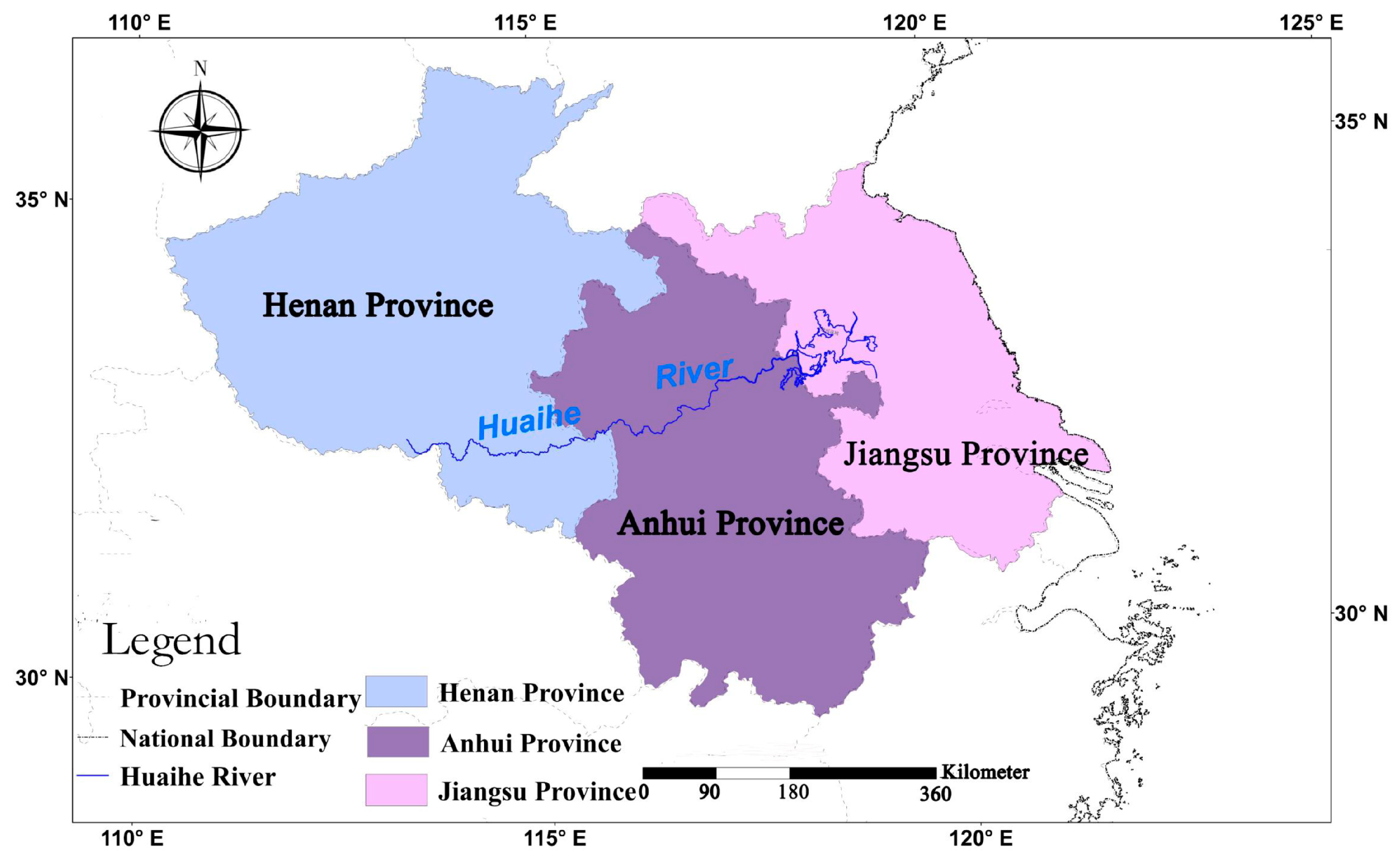
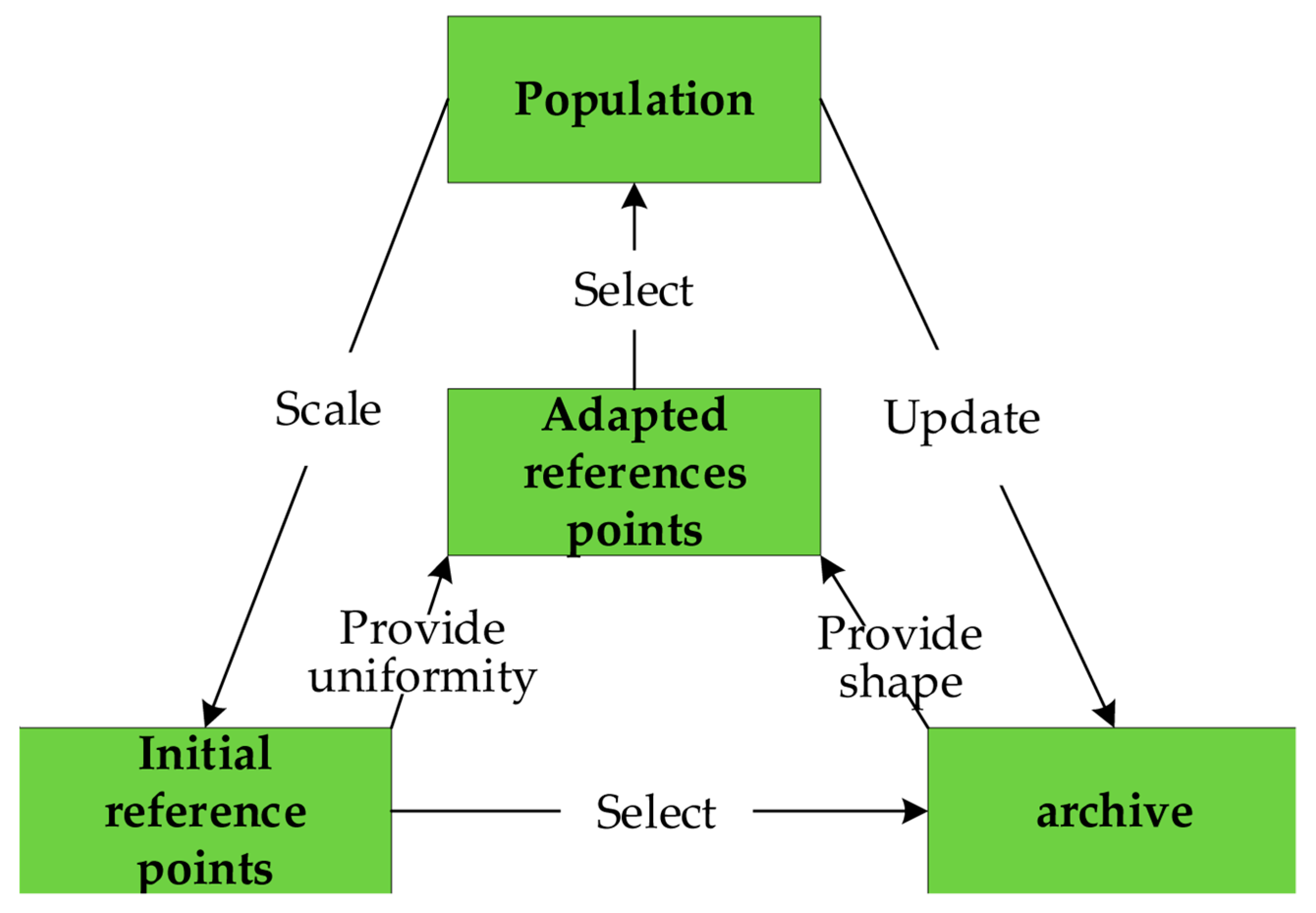
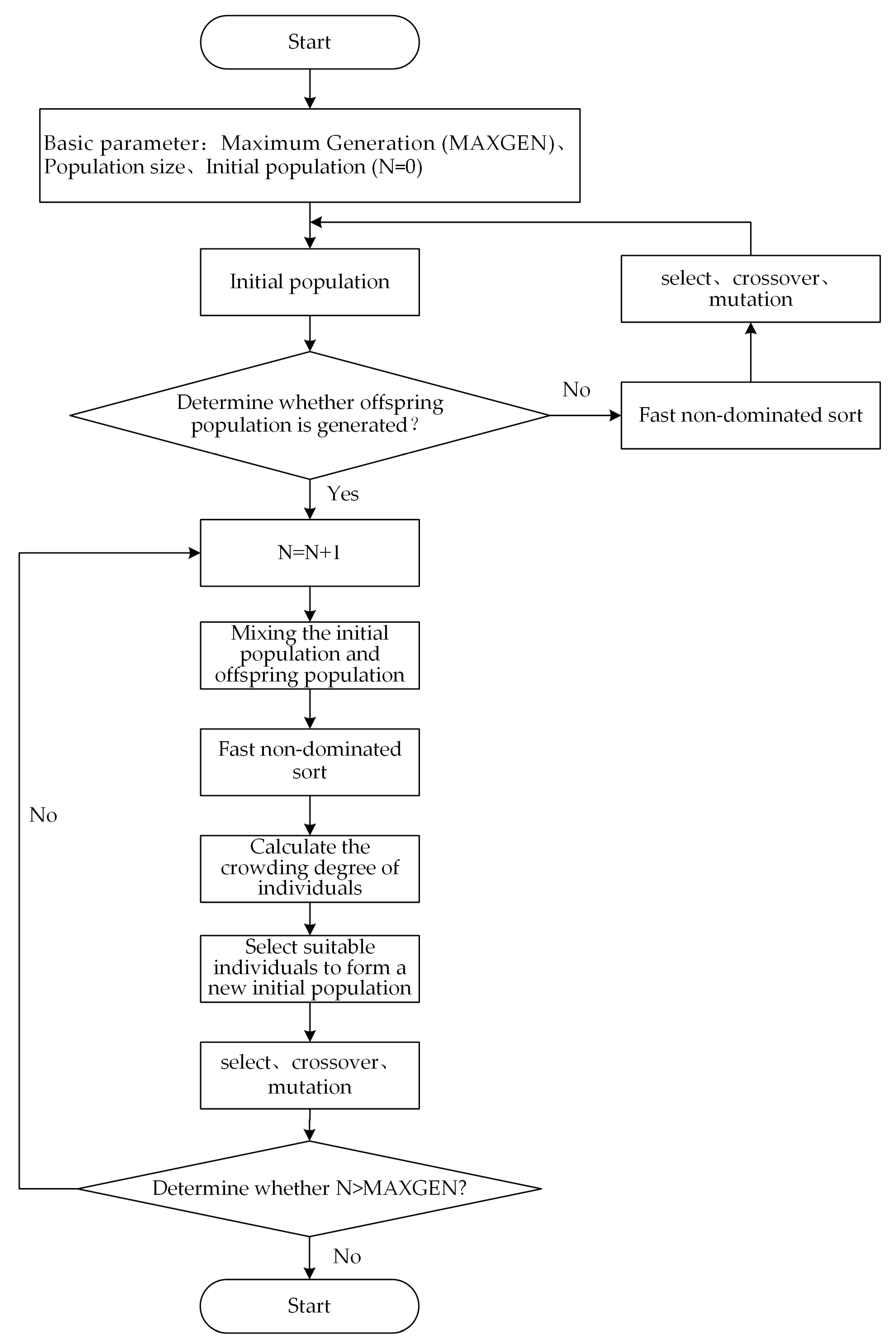

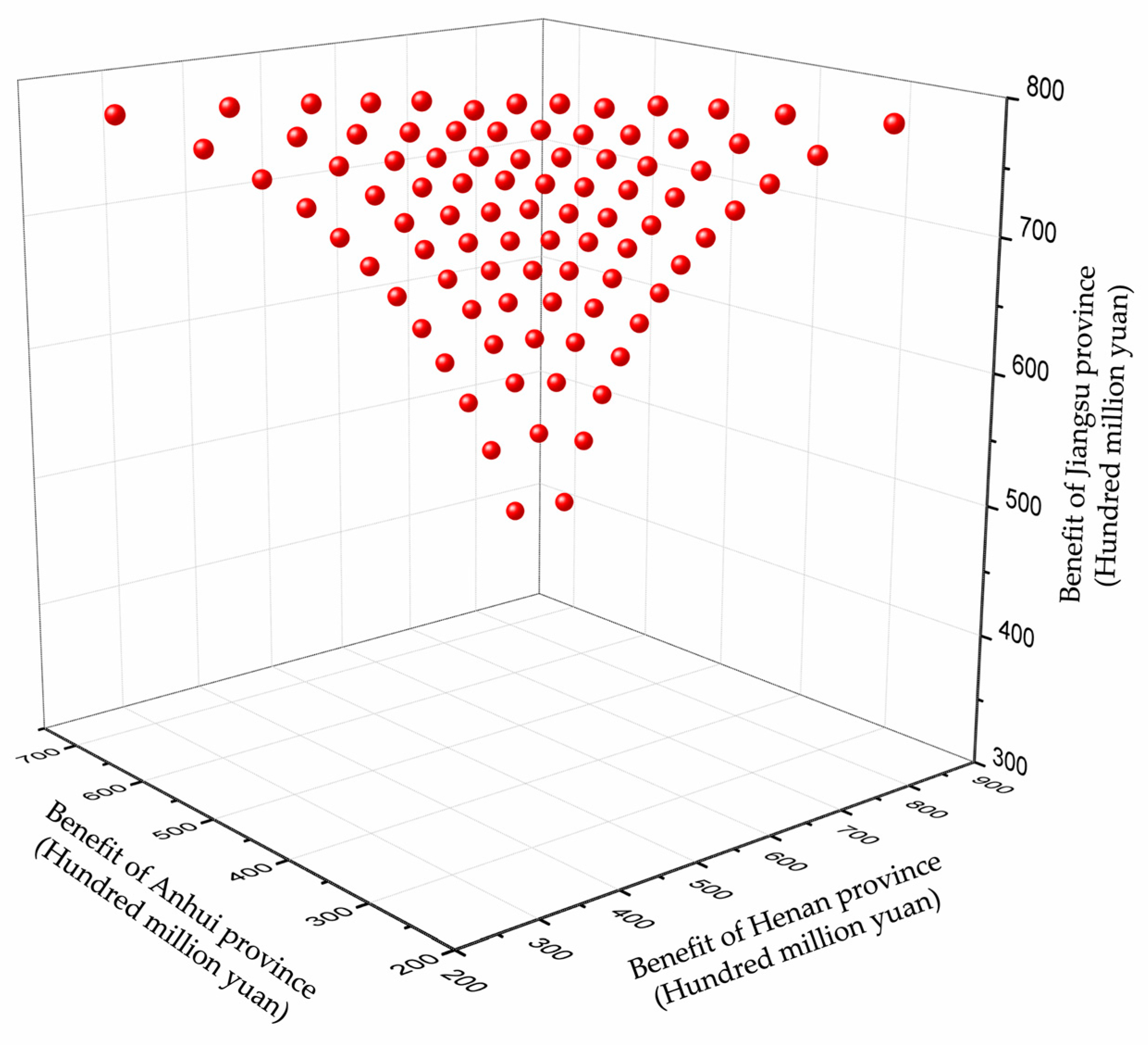
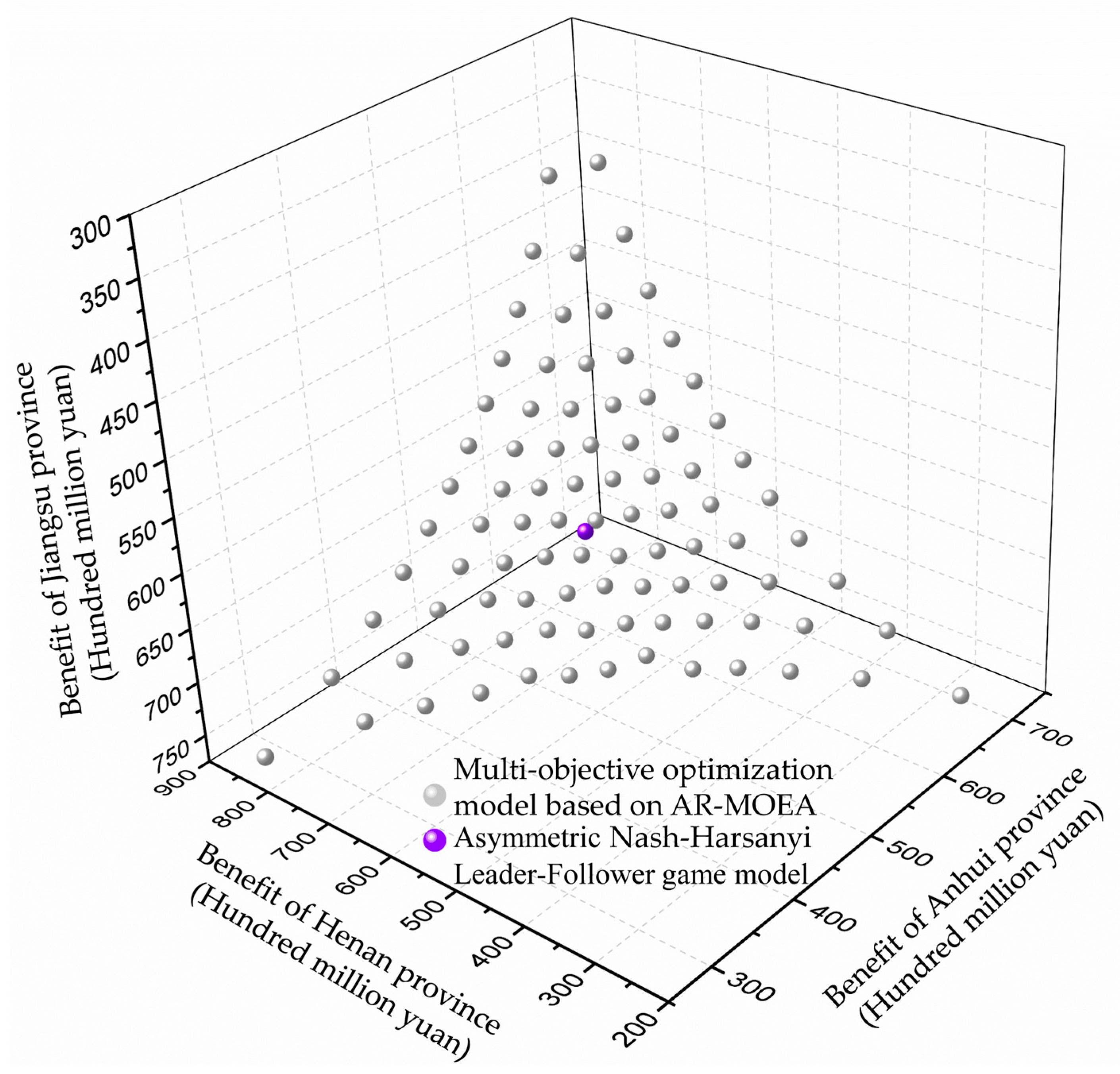
| Parameter | Henan Province | Anhui Province | Jiangsu Province |
|---|---|---|---|
| 400.5 (Hundred million m3) | |||
| 100.1 (Hundred million m3) | |||
| 0.667 | |||
| 0.333 | |||
| 126.4 (Hundred million m3) | 135.2 (Hundred million m3) | 137.3 (Hundred million m3) | |
| 27.7 (Hundred million m3) | 37.0 (Hundred million m3) | 50.4 (Hundred million m3) | |
| 27.9 (Hundred million m3) | 37.0 (Hundred million m3) | 50.4 (Hundred million m3) | |
| 273.443 (Hundred million yuan) | 289.476 (Hundred million yuan) | 389.663 (Hundred million yuan) | |
| 666.8 (m3/Hundred million yuan) | 1035.2 (m3/Hundred million yuan) | 1034.7 (m3/Hundred million yuan) | |
| 0.423 | 0.288 | 0.289 | |
| Metrics | Average Value | Significance Test | |
|---|---|---|---|
| NSGA-II Method | AR-MOEA Method | ||
| Convergence metric GD | 17.18 | 16.99 | h = 0 1 |
| Diversity metric | 2.74 | 1.97 | h = 1 2 |
| Composite metric IGD | 40.94 | 40.93 | h = 0 |
| Composite metric HV | 3.22 | 3.30 | h = 0 |
| Province | Parameters | Multi-Objective Optimization Solution | Asymmetric Nash–Harsanyi Leader–Follower Game Model | |
|---|---|---|---|---|
| Efficiency | Fairness | |||
| Henan | w1 (Hundred million m3) | 107.8 | 92.2 | 95.5 |
| F1 (Hundred million yuan) | 788.8 | 718.4 | 734.6 | |
| water demand satisfaction rate (%) | 81.1 | 65.3 | 68.6 | |
| Anhui | w2 (Hundred million m3) | 90.5 | 101.1 | 97.5 |
| F2 (Hundred million yuan) | 573.7 | 613.7 | 600.8 | |
| water demand satisfaction rate (%) | 54.5 | 65.3 | 61.6 | |
| Jiangsu | w3 (Hundred million m3) | 102.1 | 107.1 | 107.4 |
| F3 (Hundred million yuan) | 662.6 | 682.2 | 683.3 | |
| water demand satisfaction rate (%) | 59.5 | 65.3 | 65.6 | |
| Total benefit (Hundred million yuan) | 2025.1 | 2014.3 | 2018.7 | |
Publisher’s Note: MDPI stays neutral with regard to jurisdictional claims in published maps and institutional affiliations. |
© 2021 by the authors. Licensee MDPI, Basel, Switzerland. This article is an open access article distributed under the terms and conditions of the Creative Commons Attribution (CC BY) license (https://creativecommons.org/licenses/by/4.0/).
Share and Cite
Fu, J.; Zhong, P.-A.; Xu, B.; Zhu, F.; Chen, J.; Li, J. Comparison of Transboundary Water Resources Allocation Models Based on Game Theory and Multi-Objective Optimization. Water 2021, 13, 1421. https://doi.org/10.3390/w13101421
Fu J, Zhong P-A, Xu B, Zhu F, Chen J, Li J. Comparison of Transboundary Water Resources Allocation Models Based on Game Theory and Multi-Objective Optimization. Water. 2021; 13(10):1421. https://doi.org/10.3390/w13101421
Chicago/Turabian StyleFu, Jisi, Ping-An Zhong, Bin Xu, Feilin Zhu, Juan Chen, and Jieyu Li. 2021. "Comparison of Transboundary Water Resources Allocation Models Based on Game Theory and Multi-Objective Optimization" Water 13, no. 10: 1421. https://doi.org/10.3390/w13101421
APA StyleFu, J., Zhong, P.-A., Xu, B., Zhu, F., Chen, J., & Li, J. (2021). Comparison of Transboundary Water Resources Allocation Models Based on Game Theory and Multi-Objective Optimization. Water, 13(10), 1421. https://doi.org/10.3390/w13101421







